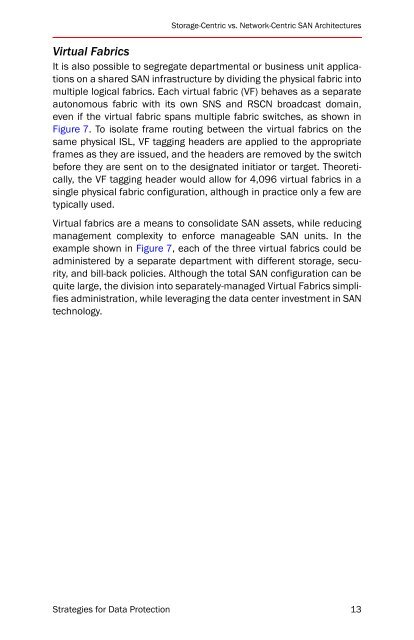- Page 1 and 2: STRATEGIESFOR DATAPROTECTIONFIRST E
- Page 3: This book is dedicated to the memor
- Page 6 and 7: About the AuthorTom Clark is a resi
- Page 8 and 9: ContentsChapter 3: Disaster Recover
- Page 10 and 11: ContentsChapter 12: Advanced Fabric
- Page 12 and 13: FiguresFigure 23. Combining disk-to
- Page 14 and 15: FiguresxivStrategies for Data Prote
- Page 16 and 17: IntroductionIn this book we will ex
- Page 18 and 19: Introductionthe already altered dat
- Page 20 and 21: IntroductionviStrategies for Data P
- Page 22 and 23: 2 Strategies for Data Protection
- Page 24 and 25: Chapter 1: Building the FoundationS
- Page 26 and 27: Chapter 1: Building the FoundationF
- Page 28 and 29: Chapter 1: Building the FoundationI
- Page 30 and 31: Chapter 1: Building the Foundatione
- Page 34 and 35: Chapter 1: Building the FoundationF
- Page 36 and 37: Chapter 1: Building the FoundationH
- Page 38 and 39: Chapter 1: Building the FoundationF
- Page 40 and 41: Chapter 1: Building the FoundationW
- Page 42 and 43: Chapter 1: Building the FoundationA
- Page 44 and 45: Chapter 1: Building the Foundatione
- Page 46 and 47: Chapter 1: Building the FoundationF
- Page 48 and 49: Chapter 1: Building the FoundationF
- Page 50 and 51: Chapter 1: Building the FoundationI
- Page 52 and 53: Chapter 1: Building the FoundationF
- Page 54 and 55: Chapter 1: Building the FoundationS
- Page 56 and 57: Chapter 1: Building the FoundationF
- Page 58 and 59: Chapter 2: Backup StrategiesTape ba
- Page 60 and 61: Chapter 2: Backup StrategiesIn addi
- Page 62 and 63: Chapter 2: Backup Strategiesbackup
- Page 64 and 65: Chapter 2: Backup StrategiesBecause
- Page 66 and 67: Chapter 2: Backup StrategiesFigure
- Page 68 and 69: Chapter 2: Backup StrategiesTape Pi
- Page 70 and 71: Chapter 2: Backup Strategies50 Stra
- Page 72 and 73: Chapter 3: Disaster RecoveryDefinin
- Page 74 and 75: Chapter 3: Disaster RecoveryTier 4.
- Page 76 and 77: Chapter 3: Disaster RecoveryFigure
- Page 78 and 79: Chapter 3: Disaster RecoveryLeverag
- Page 80 and 81: Chapter 3: Disaster Recoveryto serv
- Page 82 and 83:
Chapter 3: Disaster RecoveryFigure
- Page 84 and 85:
Chapter 3: Disaster RecoveryJumbo F
- Page 86 and 87:
Chapter 3: Disaster RecoveryFastWri
- Page 88 and 89:
Chapter 3: Disaster RecoveryFigure
- Page 90 and 91:
Chapter 3: Disaster RecoveryDisaste
- Page 92 and 93:
Chapter 3: Disaster Recoverygeograp
- Page 94 and 95:
Chapter 3: Disaster RecoveryDisaste
- Page 96 and 97:
Chapter 4: Continuous Data Protecti
- Page 98 and 99:
Chapter 4: Continuous Data Protecti
- Page 100 and 101:
Chapter 4: Continuous Data Protecti
- Page 102 and 103:
Chapter 5: Information Lifecycle Ma
- Page 104 and 105:
Chapter 5: Information Lifecycle Ma
- Page 106 and 107:
Chapter 5: Information Lifecycle Ma
- Page 108 and 109:
Chapter 5: Information Lifecycle Ma
- Page 110 and 111:
Chapter 5: Information Lifecycle Ma
- Page 112 and 113:
Chapter 5: Information Lifecycle Ma
- Page 114 and 115:
Chapter 5: Information Lifecycle Ma
- Page 116 and 117:
Chapter 5: Information Lifecycle Ma
- Page 118 and 119:
Chapter 6: Infrastructure Lifecycle
- Page 120 and 121:
Chapter 6: Infrastructure Lifecycle
- Page 122 and 123:
Chapter 6: Infrastructure Lifecycle
- Page 124 and 125:
Chapter 7: Extending Data Protectio
- Page 126 and 127:
Chapter 7: Extending Data Protectio
- Page 128 and 129:
Chapter 7: Extending Data Protectio
- Page 130 and 131:
Chapter 7: Extending Data Protectio
- Page 132 and 133:
Chapter 7: Extending Data Protectio
- Page 134 and 135:
114 Strategies for Data Protection
- Page 136 and 137:
Chapter 8: Foundation ProductsBroca
- Page 138 and 139:
Chapter 8: Foundation ProductsTable
- Page 140 and 141:
Chapter 8: Foundation ProductsUtili
- Page 142 and 143:
Chapter 8: Foundation ProductsBroca
- Page 144 and 145:
Chapter 8: Foundation ProductsBroca
- Page 146 and 147:
Chapter 8: Foundation ProductsBroca
- Page 148 and 149:
Chapter 8: Foundation ProductsBroca
- Page 150 and 151:
Chapter 8: Foundation ProductsBroca
- Page 152 and 153:
Chapter 8: Foundation ProductsBy ut
- Page 154 and 155:
Chapter 9: Distance ProductsThe Bro
- Page 156 and 157:
Chapter 9: Distance ProductsBrocade
- Page 158 and 159:
Chapter 10: Backup and Data Protect
- Page 160 and 161:
Chapter 10: Backup and Data Protect
- Page 162 and 163:
Chapter 10: Backup and Data Protect
- Page 164 and 165:
Chapter 11: Branch Office and File
- Page 166 and 167:
Chapter 11: Branch Office and File
- Page 168 and 169:
Chapter 11: Branch Office and File
- Page 170 and 171:
Chapter 12: Advanced Fabric Service
- Page 172 and 173:
Chapter 12: Advanced Fabric Service
- Page 174 and 175:
Chapter 12: Advanced Fabric Service
- Page 176 and 177:
Chapter 12: Advanced Fabric Service
- Page 178 and 179:
Chapter 12: Advanced Fabric Service
- Page 180 and 181:
Chapter 12: Advanced Fabric Service
- Page 182 and 183:
Chapter 12: Advanced Fabric Service
- Page 184 and 185:
Chapter 13: Solutions Productsmany
- Page 186 and 187:
Chapter 13: Solutions Products166 S
- Page 188 and 189:
Appendix A: The Storage Networking
- Page 190 and 191:
Appendix A: The Storage Networking
- Page 192 and 193:
Appendix A: The Storage Networking
- Page 194:
STRATEGIES FORDATA PROTECTIONFIRST
















